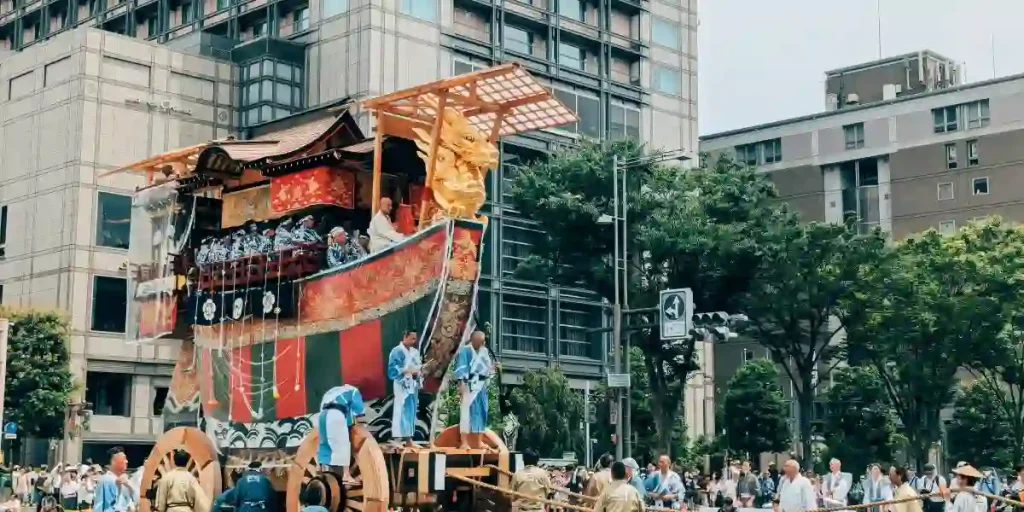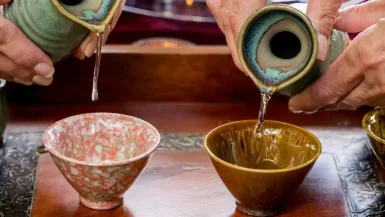Japan embraces a rich history, where ancient customs and rituals seamlessly intertwine with modern life. Generations have preserved these Japanese traditions, maintaining the essence of Japan’s unique cultural identity. In this article, we will explore various aspects of Japanese traditions, from tea ceremonies and seasonal festivals to martial arts and family customs. By understanding these traditions, one can gain a deeper appreciation for the rich heritage that continues to shape Japan today.
The Essence of Japanese Traditions in Everyday Life
Japanese traditions deeply influence the daily lives of its people. From the moment you step foot in a Japanese home, you encounter customs that people have practiced for centuries. One of the most notable Japanese traditions is the custom of removing shoes before entering a home. This practice is not merely about cleanliness; it symbolizes respect for the home and its inhabitants. Guests are often provided with slippers to wear indoors, further emphasizing the importance of this tradition.
Another daily tradition is the practice of bowing. Bowing is a fundamental aspect of Japanese etiquette, used in various social interactions to express respect, gratitude, and humility. The depth and duration of a bow can vary depending on the situation and the relationship between individuals. In business settings, bowing is an essential part of formal greetings and farewells, reflecting the importance of respect in Japanese traditions.
The Timeless Art of the Japanese Tea Ceremony
The Japanese tea ceremony, known as chanoyu or sado, is one of the most iconic Japanese traditions. This ritualistic practice dates back to the 9th century when tea was first introduced to Japan from China.
Hosts often hold the tea ceremony in a traditional tea room, featuring minimalistic décor and a serene atmosphere. They meticulously perform every aspect of the ceremony, from preparing the tea to arranging the tea utensils. The host and guests engage in a series of prescribed gestures, each carrying deep symbolic meaning.
The tea ceremony is a profound reflection of the Japanese way of life, where even the most ordinary activities are imbued with a sense of ritual and reverence.
Festivals: Celebrating Japanese Traditions Throughout the Year
Japanese festivals, or matsuri, are vibrant expressions of the country’s rich cultural heritage. These festivals are deeply connected to Japanese traditions, often rooted in religious practices, agricultural cycles, and historical events.
One of the most famous Japanese traditions is the celebration of the Obon festival, which honors the spirits of deceased ancestors. Obon occurs in mid-August, with various rituals marking the event, including the lighting of bonfires and the floating of lanterns to guide the spirits back to the afterlife.
Another significant festival is Shogatsu, the Japanese New Year, which is perhaps the most important holiday in Japan. This celebration is steeped in Japanese traditions that date back centuries. Leading up to the New Year, families clean their homes thoroughly to remove any bad luck from the previous year. They also prepare osechi-ryori, a special set of dishes with symbolic meanings, such as kuromame (black beans) for good health and kazunoko (herring roe) for prosperity.
On New Year’s Day, it is a tradition to visit a shrine for hatsumode, the first prayer of the year. People pray for health, happiness, and success in the coming year. Families cherish the tradition of giving and receiving otoshidama (money envelopes) among children during Shogatsu. It reflects the importance of family and prosperity in Japanese culture.

The Spiritual Significance of Japanese Traditions in Shinto and Buddhism
One of the key Shinto rituals is the purification ceremony known as misogi. This ritual involves the washing of hands and mouth at the entrance of a shrine, symbolizing the cleansing of impurities before approaching the divine.
Buddhism, which was introduced to Japan in the 6th century, has also significantly influenced Japanese traditions. Buddhist rituals often center around the concepts of impermanence and the cycle of life and death. One of the most profound Japanese traditions rooted in Buddhism is the Jizo Bosatsu veneration. Jizo, a bodhisattva, protects children, travelers, and those in the afterlife. Parents throughout Japan often place statues of Jizo adorned with red bibs and hats, praying for the well-being of their children.
Buddhist traditions also include the practice of zazen (seated meditation), which is central to Zen Buddhism.
The Art of Japanese Calligraphy: A Tradition of Grace and Precision
Japanese calligraphy, or shodo, is an art form that embodies the elegance and discipline of Japanese traditions. The practice of shodo involves writing Japanese characters with brush and ink, following precise strokes and techniques. Each stroke in calligraphy is carefully executed, reflecting the artist’s state of mind and mastery of the craft.
Shodo is not merely about writing; it is a meditative practice that requires focus and patience. The fluid movements of the brush and the balance of the characters on the paper are symbolic of the harmony and order that are central to Japanese traditions.
Japanese Traditions in Martial Arts: Discipline, Respect, and Honor
Martial arts are an integral part of Japanese traditions, embodying the principles of discipline, respect, and honor. Japanese martial arts, such as judo, kendo, karate, and aikido, are not just physical practices but also spiritual and philosophical disciplines.
One of the most revered Japanese traditions in martial arts is the concept of bushido, or “the way of the warrior.” Bushido is a code of conduct that originated with the samurai, the warrior class of ancient Japan. It stresses virtues such as loyalty, courage, and integrity, which are still deeply respected in modern Japanese society. Although the samurai class no longer exists, the spirit of bushido continues to influence Japanese traditions, especially in martial arts.
The practice of kata, or forms, is another important aspect of Japanese martial arts. Kata are pre-arranged sequences of movements that simulate combat scenarios. Practicing kata helps martial artists develop precision, timing, and awareness. It is a tradition that emphasizes the importance of repetition and mastery, values that are central to Japanese traditions in general.
Japanese Traditions in Cuisine: The Art of Seasonal and Aesthetic Dining
Japanese cuisine is not only about taste but also about aesthetics and seasonal harmony, which are deeply ingrained in Japanese traditions. The concept of washoku, or traditional Japanese food, emphasizes the use of seasonal ingredients and the balance of flavors, colors, and textures.
One of the most iconic Japanese traditions in cuisine is kaiseki, a multi-course meal that originated from the tea ceremony. Kaiseki is a culinary art form that showcases the chef’s skill in presenting seasonal ingredients in a way that pleases both the palate and the eyes.
Sushi, another prominent aspect of Japanese cuisine, reflects Japanese traditions. The preparation of sushi involves a high level of skill and precision, with an emphasis on the freshness and quality of the ingredients.
Traditional Japanese Clothing: A Reflection of Cultural Identity
Traditional Japanese clothing, particularly the kimono, is one of the most visually striking aspects of Japanese traditions. The kimono, with its elegant lines and intricate designs, is a symbol of Japanese cultural identity and craftsmanship. Although Western clothing is now the norm in Japan, the kimono remains an important garment for special occasions and ceremonies.
The process of putting on a kimono, known as kitsuke, requires careful attention to detail. Tradition governs every aspect, from the way the obi (sash) is tied to the selection of the appropriate kimono for the occasion. Women, in particular, often take classes to learn the proper techniques of kitsuke, ensuring they pass this knowledge down through generations.
The kimono is not the only traditional Japanese garment. People commonly wear the yukata, a lighter, cotton version of the kimono, during summer festivals and events. Wearing the yukata feels simpler and suits more casual and relaxed occasions.
Traditional clothing is also closely linked to other Japanese traditions, such as tea ceremonies, weddings, and festivals.
Japanese Traditions in Family and Social Structures
Family plays a central role in Japanese traditions, where the concept of ie (household) has historically governed the social structure. In traditional Japanese families, people often viewed the household as a single unit, with clearly defined roles and responsibilities based on age, gender, and social status.
One of the most enduring Japanese traditions related to family is the practice of seijin shiki, or Coming of Age Day. This ceremony is held annually in January. It marks the transition from youth to adulthood for those who have turned 20 years old. The event is celebrated with formal ceremonies at local government offices. Young adults dress in traditional clothing, such as kimonos for women and hakama for men.
The respect for elders is another key aspect of Japanese traditions within the family. This respect is often demonstrated through daily interactions. For example, using polite language (known as keigo) when speaking to older family members is a common practice. The practice of obon also reflects this respect. It involves honoring deceased ancestors and recognizing the continuity of the family lineage.
Marriage customs prominently display Japanese traditions in another important area. Couples often hold traditional Japanese weddings, famous as shinzen kekkon, at Shinto shrines, where a priest blesses them in a sacred ritual. The wedding ceremony involves various symbolic acts, such as the exchange of sake cups (san-san-kudo) between the bride and groom. This ritual symbolizes the joining of two families. While Western-style weddings have become increasingly popular in Japan, many couples still incorporate elements of traditional Japanese customs into their ceremonies, blending the old with the new.
The Role of Nature in Japanese Traditions
Nature holds a revered place in Japanese traditions, deeply influencing the country’s cultural practices and spiritual beliefs. The Japanese relationship with nature is rooted in both Shintoism and Buddhism. These religions emphasize the sanctity of natural elements and the interconnectedness of all living things.
One of the most cherished Japanese traditions that reflect this relationship is the hanami (flower viewing) custom. Hanami, particularly the viewing of cherry blossoms, is a time-honored tradition that dates back over a thousand years.
Another important tradition is momijigari, the practice of viewing autumn leaves. Similar to hanami, momijigari involves admiring the vibrant colors of the changing leaves, particularly those of the Japanese maple tree. This tradition, like many others in Japan, emphasizes the importance of living in harmony with the natural world. It also highlights the need to appreciate the beauty that each season brings.
Japanese Traditions in Arts and Crafts: The Pursuit of Perfection
Japanese arts and crafts are a testament to the country’s dedication to tradition and the pursuit of perfection. Artisans have practiced many of these crafts for centuries, passing them down through generations while honing their skills to the highest level.
One of the most well-known Japanese traditions in craftsmanship is pottery. Japan has a rich history of pottery-making, with different regions known for their distinctive styles, such as Kyo-yaki from Kyoto and Imari porcelain from Kyushu.
Another traditional craft is origami, the art of paper folding. Origami is a beloved Japanese tradition that transforms a simple piece of paper into intricate shapes and designs, ranging from delicate cranes to complex geometric forms.
Lacquerware is another ancient Japanese craft that exemplifies the country’s traditions of meticulous workmanship. Artisans create Japanese lacquerware, famous as urushi, by applying multiple layers of lacquer made from the sap of the urushi tree to wooden or metal objects.
Japanese Traditions in Performing Arts: The Fusion of Storytelling and Ritual
Japanese traditions deeply root performing arts, blending storytelling, music, dance, and ritual into powerful forms of cultural expression. Traditions in the performing arts are diverse. They range from the ancient Noh and Kabuki theaters to the more modern Bunraku puppet theater.
Noh theater is one of Japan’s oldest performing arts, dating back to the 14th century. Noh combines drama, music, and dance in a highly stylized form, with actors wearing elaborate masks and costumes.
Kabuki theater, in contrast, is prominent for its energetic performances, colorful costumes, and dramatic makeup. It emerged in the 17th century and quickly became popular among the common people for its lively storytelling and spectacle. Kabuki plays often depict historical events, moral dilemmas, and tales of love and betrayal. Actors use exaggerated movements and vocal techniques to convey emotions.
Bunraku, or Japanese puppet theater, is another unique performing art that is an integral part of Japanese traditions. Skilled puppeteers meticulously craft and operate Bunraku puppets, bringing them to life on stage. The art of Bunraku demands years of training, with three puppeteers working in perfect harmony to control each puppet.
The Continuing Legacy of Japanese Traditions
Japanese traditions are not just relics of the past; they are living practices that continue to shape the values, behaviors, and identity of the Japanese people. They offer a sense of continuity and connection to the past, while also providing guidance and inspiration for the future. As Japan continues to evolve, its traditions remain a testament to the enduring spirit of a culture that honors its history while embracing the possibilities of tomorrow.
In conclusion, the exploration of Japanese traditions reveals a culture that is deeply respectful of its past, yet dynamic in its ability to adapt and thrive in a changing world. By understanding and appreciating these traditions, we can gain a deeper insight into the Japanese way of life. These traditions also reveal the values that continue to define this remarkable country. Whether you are visiting Japan or simply learning about its culture from afar, immersing yourself in Japanese traditions is a journey that offers both enlightenment and enrichment.



